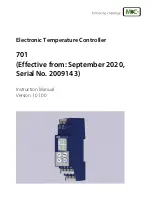
HI, LO and Deadband Setpoints
<HI and LO Relay>
Relays switch state when their user-programmable setpoint is exceeded. They switch again
when the limit is no longer exceeded. If the measurement exceeds the high setpoint, the
high relay will switch state. If the measurement is lower than the low setpoint, the low relay
will switch state. The programming steps are detailed later in this section.
<HI and LO Deadband>
The Deadband feature is used to minimize relay chatter (rapid on/off relay switching) near
setpoint. This is accomplished by creating a region where no relay action can occur. The
High Deadband parameter creates a band at the high setpoint and the Low Deadband
parameter creates a band at the low setpoint.
HI relay ON: reading > (HI relay se HI deadband)
HI relay OFF: reading < (HI relay setpoint)
LO relay ON: reading < (LO relay setpoint - LO deadband)
LO relay OFF: reading > (LO relay setpoint)
HI setpoint
pH 7
LO setpoint
HI deadband
LO deadband
HI relay ON
LO relay ON

























